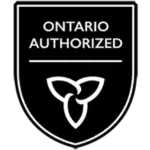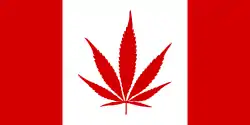Cannabis in Ontario
Cannabis in Canada has been legal for medicinal purposes since 2001 under conditions outlined in the Marihuana for Medical Purposes Regulations. This was superseded by the Access to Cannabis for Medical Purposes Regulations,[1] issued by Health Canada while seed, grain, and fibre production were permitted under licence by Health Canada.[2]

| Part of series on |
| Cannabis in Canada |
|---|
 |
| National legislation |
| Provincial and territorial regulations |
| Other jurisdictions |
|
Cannabis portal Canada portal |
The federal Cannabis Act, legalizing cannabis for recreational use, came into effect on 17 October 2018.[3][4] Each province and territory set its own laws for various aspects, such as the legal age, whether householders can grow cannabis and the method of retail sales. The latter aspect varies as to ownership of retail outlets (by the provincial government or private enterprise) but all provinces and territories include an option for on-line sales.[5][6]
In 2019, the Ontario government initially issued 25 retail licenses for brick-and-mortar stores to sell recreational cannabis; the selection was based on strict criteria and a lottery system. An additional 50 licenses were subsequently issued. By April 2020, the government planned to eliminate the lottery system and to begin issuing roughly 20 new permits per month to increase availability as part of the plan to combat sales by black market dealers.[7][8] Retail on-line sales of recreational cannabis remained in the hands of the Ontario Cannabis Store, operated by the provincial government.[9]
Legalization for recreational use
The Ontario Cannabis Retail Corporation is the sole legal wholesale distributor and online retailer of recreational cannabis in Ontario. The online store operates under the Ontario Cannabis Store (OCS) branding.[10][11][12] The initial plan for legalization was for all retail outlets in Ontario to be operated by OCS, with at least 150 OCS stores opened by 2020.
Following the election of the Progressive Conservative Party to government in the 2018 Ontario general election, the provincial government announced significant changes to the cannabis regulation and distribution system in August 2018. Plans for brick-and-mortar OCS retail outlets were cancelled, with OCS now intended to only operate as an online retailer with deliveries made by Canada Post.[13] In addition to acting as the sole online retailer of recreational cannabis in Ontario, OCS will also act as the wholesale provider for private retail stores.[14] Municipal governments were given the opportunity for indefinite opt-outs from having retail stores opened in their municipalities provided that they passed a council resolution in favour of opting out and they informed the Alcohol and Gaming Commission of Ontario in writing before 22 January 2019.[15]
In early November, Canada Post advised the OCS that the names and addresses of 4,500 customers had been accessed by an individual without authority to do so.[16]
The minimum legal age to purchase or use cannabis in Ontario is 19 (the same age that one can legally purchase alcohol or tobacco) and adults can carry up to 30 grams in public. Minors between the ages of 12-18 who possess less than five grams of cannabis can be given a provincial offences ticket of $200. If they are caught with more than five grams they will face further disciplinary action by being charged under the Youth Criminal Justice Act. However, in order to avoid the consequence of a permanent criminal record youth can be referred to complete the online Youth Cannabis Diversion program.
Cannabis edibles will not be sold for another year, but home made food and drinks can be made. Ontario's cannabis legislation allows for vaping and smoking the product in public wherever tobacco may be smoked, and subject to the same restrictions as tobacco.[17] Home growing is permitted, with up to four plants per household.[18][19]
Usage
In 2013, 12.1 percent of residents reported that they consumed cannabis in the past twelve months, the third highest in the country.[20] In 2017, Statistics Canada reported that the province had the fourth highest per capita usage in the country of 21 grams per person.[21][22]
In late November 2019, Statista released an update. On a Canada-wide basis, some 29.8 percent of adults between 25 and 34 had consumed cannabis in the previous 90 days. Usage among adults age 65 and over was only 7.6 percent. Specifics for Ontario were not available.[23]
Black market competition
Increasing the supply by increasing the number of retail outlets selling recreational cannabis in 2020 was expected to help "combat the illicit market" according to the Attorney General.[24]
For the duration of 2016-2018, the city of Hamilton was nicknamed "Hamsterdam" due to the association with Amsterdam and the cannabis market. Hamilton had a record 83 black market dispensaries at its peak.
The black market remained persistent, according to an October 2019 report, partly because of a lack of retail outlets in many communities and because of lower prices charged by dealers operating illegally. On a Canada-wide basis, the illegal product was roughly 35% less expensive, according to StatsCan. An independent cannabis research firm estimated that Canada-wide, the black market accounted for 86% of cannabis sales. Specifics for Ontario were not provided.[25]
Industrial hemp
Industrial hemp is the cannabis plant and variances that contain under 0.3% THC in the leaves and flowering heads. Under the Opium Narcotic Drug Act hemp production was prohibited in Canada in 1938 for the battle against THC abuse, now under the Controlled Drugs and Substance Act (CDSA) and subsection Industrial Hemp Regulation (IHR) permission of Canadian Farmer's under regulated approval the right to commercially produce industrial hemp on 12 March 1998.[26]
There are two separate licensing applications for individuals and corporations that gives the right to grow, sell, import/export, sterilize, clean and prepare industrial hemp. As of November 2017, there were 83 total licenses and registries in Ontario and a total of 1830 in Canada which gave rights to 22 approved cultivars in 2017 that had 55,853.97 hectares (138,018.2 acres) for cultivation of industrial hemp, 474.46 hectares (1,172.4 acres) of which was in Ontario.[27] Ontario Ministry of Agriculture, Food and Rural Affairs gives background information on industrial hemp and a fact sheet on growing industrial hemp from start to finish, idea soil conditions all the way to the economics of hemp production.[28] Uses of industrial hemp include construction materials, textiles, paper, rope and twine, various food products, cosmetics, and fuel.[29]
References
| Wikimedia Commons has media related to Cannabis in Ontario. |
- "Access to Cannabis for Medical Purposes Regulations". laws-lois.justice.gc.ca/. Retrieved 20 March 2017.
- "Industrial Hemp Regulation Program FAQ". Health Canada. November 2012. Retrieved 30 October 2013.
- Scott, Monique (20 June 2018). "Marijuana to be legal in Canada starting October 17, Trudeau confirms". Global News.
- "The Cannabis Act: The Facts". Health Canada. Government of Canada. 20 June 2018. Retrieved 27 October 2018.
- "Marijuana is legal everywhere across Canada now". Inside Halton. Metroland News. 17 October 2018. Retrieved 27 October 2018.
- "Cannabis is legal in Canada — here's what you need to know". CBC News. CBC. 17 October 2018. Retrieved 27 October 2018.
- Ontario will scrap lottery system, move to expand retail cannabis market in 2020
- Ontario removing cap on number of pot shops, opening up market for retailers
- Welcome to OCS
- Benzie, Robert (8 September 2017). "LCBO to run 150 marijuana stores". Toronto Star.
- "Ontario government's marijuana monopoly could weed out craft growers". 8 September 2017.
- "Medical marijuana producers bristle at Ontario's planned monopoly on recreational cannabis sales". 11 September 2017.
- https://www.vice.com/en_ca/article/vbn37a/doug-fords-weed-plans-are-good-actually
- "Ontario to allow private retailers to sell cannabis, province will handle online sales". CBC News. Retrieved 28 October 2018.
- "List of Ontario municipalities prohibiting or allowing cannabis retail stores". Alcohol and Gaming Commission of Ontario. Queen's Printer for Ontario. Retrieved 12 May 2019.
- "EXCLUSIVE: Names of recreational cannabis buyers hacked". Ottawa Sun. 7 November 2018. Retrieved 7 November 2018.
- "Pot is now legal in Ontario. Here's what you need to know". CBC News. 17 October 2018. Retrieved 28 October 2018.
- Kalina Laframboise (16 November 2017), Quebec government reveals details of marijuana bill: Proposed law includes plans for sale, distribution and enforcement of cannabis, CBC News
- "Cannabis is legal in Canada — here's what you need to know". CBC News. CBC. 17 October 2018. Retrieved 27 October 2018.
- "B.C., Nova Scotia home to the most marijuana smokers: StatsCan". torontosun.com. Toronto Sun. 18 September 2013. Retrieved 3 February 2019.
- Quon, Alexander (30 April 2018). "Nova Scotians smoke the most weed per capita in Canada: StatsCan". globalnews.ca. Global News. Retrieved 3 February 2019.
- "Provincial and Territorial Cannabis Economic Accounts, 2017". statcan.gc.ca. Statistics Canada. 30 April 2018. Retrieved 3 February 2019.
- Marijuana and cannabis consumption among adults in the past three months in Canada as of September 2019, by age group
- Ontario removing cap on number of pot shops, opening up market for retailers
- Cannabis 'gold rush' falling short amid cheap black market: Analysts
- "Hemp and the hemp industry Frequently Asked Questions". Government of Canada. 13 October 2018.
- "Statistics, Reports and Facts Sheets on Hemp". Government of Canada. 13 October 2018.
- "Growing Industrial Hemp in Ontario". Ontario Ministry of Agriculture, Food, and Rural Affairs. 4 January 2016.
- "Hemp and the hemp industry Frequently Asked Questions". Government of Canada. 13 October 2018.